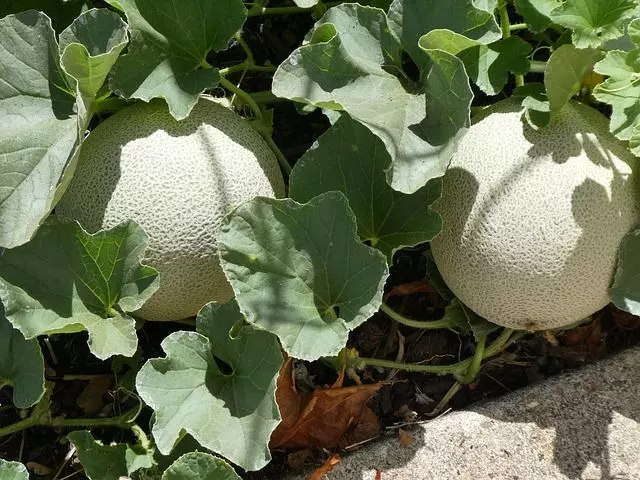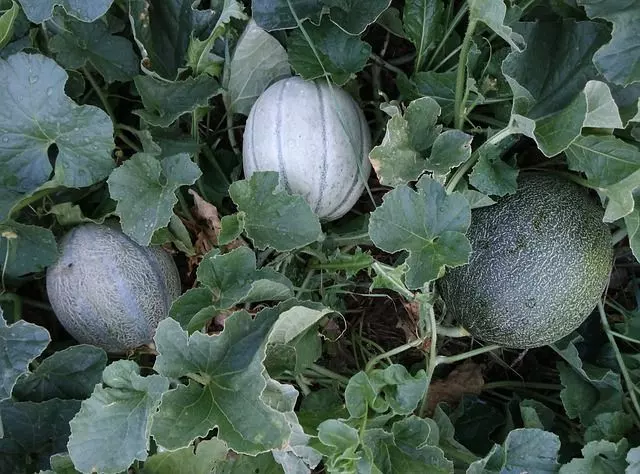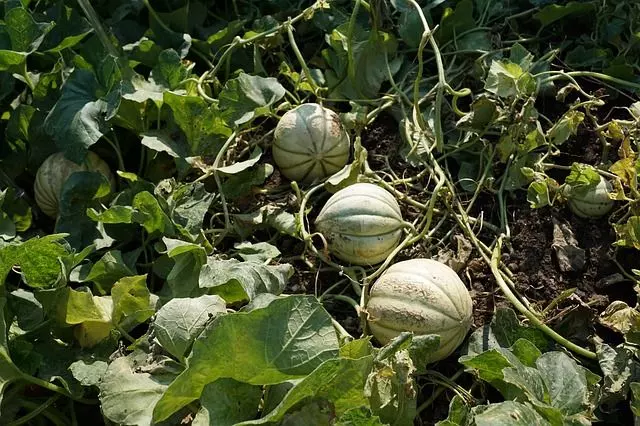Get ready to dive into the juicy world of cantaloupe melons, packed with beta-carotene, vitamin A, and powerful antioxidants! Ever wondered how to plant cantaloupe seeds for a fruitful harvest? Look no further! In this comprehensive guide, we’ll walk you through everything you need to know to cultivate these delicious orbs of goodness from seed to fruit.
Table of Contents
When to Plant Cantaloupe Seeds?
Surely, we wonder when to plant cantaloupe seeds, well the best time to plant cantaloupe seeds is in late winter and early spring.
To plant, cantaloupe seeds require warm climates for their development and are very sensitive to frost. Therefore, we will plant cantaloupe seeds in spring when the strong risk of frost is over. It is recommended not to plant it until the soil temperature reaches 60 °F (16 °C) and its optimum growing temperature is 72 to 86 °F (22 to 30 °C). We will choose a sunny area of the orchard to plant cantaloupe seeds.
- Packaged for envelope delivery.
- 50+ Seeds
- NON-GMO
How to Germinate Cantaloupe Seeds
To germinate cantaloupe seeds, we must first select our seeds, we will begin the germination process itself. To do this, we will need a glass of water and a napkin or paper towel roll.
We moisten our paper napkin in the glass with water and wring it out to remove the excess water.
We take a piece of aluminum foil, larger than the size of the paper napkin, we spread it on the table, and, inside it, we spread the moistened napkin. On it, we spread our cantaloupe seeds, keeping them separated from each other so that when they germinate their roots do not end up entangled with each other. Close the napkin in half, covering the cantaloupe seeds and pressing down so that the entire surface of the napkin is in contact with the seeds and keeps them moist.
Finally, fold the aluminum foil over the napkin. In this way, what we are doing is providing more darkness to the germination process of the cantaloupe seeds and further preserving the moisture of the seeds.
Cantaloupe seeds germinate at room temperature, so we can leave our seeds wrapped in the napkin and the foil in a warm place at home.
In only four days, you will see how your cantaloupe seeds have taken root… That is fast!
How Deep to Plant Cantaloupe Seeds
Plant cantaloupe seeds 1 to 1.5 inches deep into the soil. Planting too shallow can lead to poor germination or the seedlings drying out. Planting too deep can make it difficult for the seedlings to emerge.
How far Apart to Plant Cantaloupe
For optimal growth and yield, it’s essential to plant cantaloupe seeds or seedlings at the appropriate distance apart. Here’s a guide on how far apart to plant cantaloupe:
- Spacing Between Plants: Cantaloupe plants require adequate space to spread out and receive sufficient sunlight, air circulation, and nutrients. Plant them approximately 18 to 24 inches (45 to 60 centimeters) apart within rows.
- Row Spacing: Leave about 5 to 6 feet (1.5 to 1.8 meters) of space between rows to allow ample room for the plants to vine and for ease of access during maintenance tasks such as watering, fertilizing, and harvesting.
- Hill Planting: Alternatively, you can plant cantaloupe seeds in hills. Create mounds of soil or compost that are about 3 to 4 feet (90 to 120 centimeters) in diameter and 6 to 8 inches (15 to 20 centimeters) high. Plant 4 to 6 seeds per hill, spacing them evenly, and then thin them to the healthiest two or three plants per hill once they’ve established true leaves.
- Vertical Support: If you’re using trellises or other vertical supports for your cantaloupe plants, space them accordingly to accommodate the spread of the vines and the weight of the fruit.
By providing adequate spacing between cantaloupe plants, you’ll promote healthy growth, minimize competition for nutrients, reduce the risk of disease, and make it easier to manage and harvest your crop throughout the growing season.

How to Plant Cantaloupe Seeds Step by Step
We already know the depth, distance, and sowing time we need to know how to plant cantaloupe seeds, now we will learn the steps to plant cantaloupe. Use a substrate enriched with compost and peat to plant cantaloupe seeds.
- We will start by wetting the cantaloupe seeds for at least one hour before sowing them in the seedbeds.
- The first step is to germinate cantaloupe seeds before planting them in the ground, in the meantime, we can prepare our garden and choose the best conditions for our plants.
- The cantaloupe seeds can germinate in the seedbeds in any season; however, it needs sun and a place with warm temperatures.
- Therefore, it is recommended that if you are in a place with long winters and short summers, you carry out your germination process indoors until the warm conditions of the environment allow repotting.
- Keep in mind that cantaloupe seeds will not germinate if there are temperatures below 68 °F (20º C), that is why we recommend planting cantaloupe seeds in early spring after the last winter frost.
To know how long it takes for cantaloupe seeds to germinate, we should count on at least a period of 10 to 15 days, however, this will depend on the growing conditions.
When the cantaloupe seedlings are bigger and the weather is suitable, they will be transplanted outdoors or in a large pot.

Growing and Caring for Cantaloupe Plant
Now that we have seen when and how to plant cantaloupe seeds, let’s proceed to see the necessary care to take into account for them to develop properly. Follow these indications if you want to know how to plant cantaloupe successfully:
Temperature for Cantaloupe
A critical factor for the optimal growth of cantaloupe is temperature, as it plays a pivotal role in its development. Cantaloupes thrive in warm conditions, requiring temperatures that are consistently high enough to support their growth and fruiting stages. Cantaloupe is very sensitive to low temperatures, and if you want your melon tree to develop well and bear good fruits, you must keep it between 73 °F and 86 °F (23 and 30ºC). For this reason, it is important to dedicate a location with good lighting. Additionally, on cold days, you should cover the cantaloupe plant with some type of plastic or tarp that will not crush it and will help it maintain a stable temperature.
Watering Cantaloupe
Cantaloupe has huge water content. With this in mind, it is not hard to imagine that the plant needs a good supply of it to grow healthy and bear large fruit. In the warm months, water your cantaloupe plants daily, making sure that the soil is always moist and does not dry out completely. In the cold months, you can space watering a little to prevent the soil temperature from dropping too low.
Fertilizer for Cantaloupe
Cantaloupe plants have high nutrient requirements, necessitating nutrient-rich soil for optimal growth and fruit production. It’s recommended to enrich the soil with organic matter such as compost or humus regularly. During the warm months, apply compost or humus twice a month to ensure a steady supply of nutrients. In colder months, reduce the frequency to once a month or every two months to accommodate the plant’s reduced growth rate. For effective fertilization, consider using a balanced 5-1-5 fertilizer formulated specifically for melons, providing essential nutrients in the right proportions to support healthy development and abundant fruiting.
- 🌱 PERFECT BLEND: Our nutrient-rich 5-1-5 concentrate fertilizer blend, with its optimal balance of nitrogen, phosphorus, and potassium, ensures robust vine growth, strong root systems, and bountiful harvests of healthy, vibrant melons in your garden.
Soil for Cantaloupe
Although we have already said that this plant needs a lot of water, the soil mustn’t become waterlogged at any time. That is why we recommend that you provide good drainage to the area where you plant cantaloupe.
Cantaloupe does not tolerate acidic soil conditions, which can affect flowering and cause flower drop. The cantaloupe crop grows best in loamy soils with a pH ranging from 6 to 6.8. The crop can grow well up to a pH of 7.6, if there are no deficiencies of essential elements. Learn more about How to Measure Soil pH.
When to Harvest Cantaloupe?
The ideal time to pick cantaloupe is between late summer and early fall. The characteristic smell of the fruit will tell you if it is time to pick it or not because if you can smell the cantaloupe even through the peel, it means that everything has gone well, and you can pick your cantaloupe calmly.




